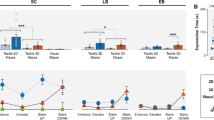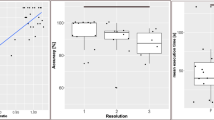Abstract
The access to graphical information is difficult for individuals who are blind or visually impaired. Taking advantage of the residual sensory abilities such as touch is one way to solve this issue. However, it is not yet clear if blind subjects perceive new tacto-spatial information in the same way that sighted people do. In this work we code the discovery of unknown tactile virtual objects in terms of subjective and behavioral variables, which result to be in-dependent on visual deprivation and dependent only on task difficulty. Our methodology can be employed in educational, orientation and mobility protocols.
Access this chapter
Tax calculation will be finalised at checkout
Purchases are for personal use only
Preview
Unable to display preview. Download preview PDF.
Similar content being viewed by others
References
Picard, D., Lebaz, S.: Identifying raised-line drawings by touch: A hard but not impossible task. Journal of Visual Impairment & Blindness 106, 427–431 (2012)
Bach-y-Rita, P., Kercel, S.W.: Sensory Substitution and the Human-Machine Interface. Trends in Cognitive Sciences 7, 541–546 (2003)
James, T.W., et al.: Haptic study of three-dimensional objects acti-vates extrastriate visual areas. Neuropsychologia 40, 1706–1714 (2002)
Campus, C., et al.: Tactile exploration of virtual objects for blind and sighted people: the role of beta 1 EEG band in sensory substitution and supramodal mental mapping. Journal of Neurophysiology 107, 2713–2729 (2012)
Struiksma, M.E., Noordzij, M.L., Postma, A.: What is the link be-tween language and spatial images? Behavioral and neural findings in blind and sighted individuals. Acta Psychologica 132, 145–156 (2009)
Lahav, O., Mioduser, D.: Construction of cognitive maps of un-known spaces using a multi-sensory virtual environment for people who are blind. Comput. Hum. Behav. 24, 1139–1155 (2008)
Ungar, S.: Cognitive Mapping without Visual Experience. Cognitive Mapping: Past, Present, and Future 4 (2000)
Brayda, L., Campus, C., Gori, M.: Predicting successful tactile mapping of virtual objects. IEEE Transaction on Haptics 6 (2013)
R Core Team. R: A language and environment for statistical computing. R Foundation for Statistical Computing, Vienna, Austria (2013), http://www.R-project.org/
Brayda, L., et al.: An Investigation of Search Behaviour in a Tactile Exploration Task for Sighted and Non-Sighted Adults. In: Proc. Extended Abstracts on Human Factors in Computing Systems (2011)
Author information
Authors and Affiliations
Editor information
Editors and Affiliations
Rights and permissions
Copyright information
© 2014 Springer International Publishing Switzerland
About this paper
Cite this paper
Memeo, M., Campus, C., Brayda, L. (2014). Do Blind Subjects Differ from Sighted Subjects When Exploring Virtual Tactile Maps?. In: Miesenberger, K., Fels, D., Archambault, D., Peňáz, P., Zagler, W. (eds) Computers Helping People with Special Needs. ICCHP 2014. Lecture Notes in Computer Science, vol 8548. Springer, Cham. https://doi.org/10.1007/978-3-319-08599-9_3
Download citation
DOI: https://doi.org/10.1007/978-3-319-08599-9_3
Publisher Name: Springer, Cham
Print ISBN: 978-3-319-08598-2
Online ISBN: 978-3-319-08599-9
eBook Packages: Computer ScienceComputer Science (R0)




